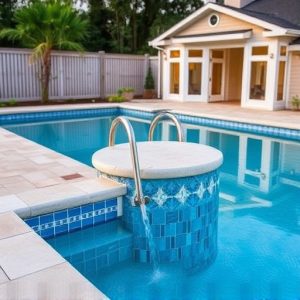Inground Pool Safety: A Guide to Swimming Pool Alarm Systems
Swimming pool alarms for inground pools are a vital safety feature that detect unauthorized access …….
Swimming pool alarms for inground pools are a vital safety feature that detect unauthorized access or falls into the water, alerting users with an audible signal. These alarms complement physical barriers like fencing and gates, forming part of a comprehensive safety strategy that includes other protective measures such as pool covers. They are essential for all pool owners, particularly those with young children or pets, to prevent pool-related incidents. The alarms come in various types, including perimeter, motion, and underwater pressure-sensitive models, with wireless options offering flexibility in installation. It's crucial to select an alarm suited to the specific pool dimensions and environment, and to calibrate it properly for optimal effectiveness. Regular maintenance, monthly inspections, and testing are necessary to ensure these systems remain reliable. A complete inground pool safety setup also encompasses robust fencing with self-closing and self-latching gates, clear signage, underwater lighting, and non-slip deck surfaces, all working together to provide a comprehensive protective environment around the pool.
safeguarding your inground pool is paramount for the well-being of swimmers and compliance with safety regulations. This article delves into the critical aspect of pool protection by focusing on swimming pool alarms for ingground pools, a vital layer of defense. We will explore the importance of these systems, the array of alarm types available, optimal installation and placement to maximize effectiveness, and maintenance best practices to ensure consistent reliability. Additionally, we’ll discuss complementary safety measures that can be integrated with your inground pool alarm system for a comprehensive approach to safety.
Understanding the Importance of Pool Protection for Inground Pools
When it comes to safeguarding your inground pool, installing a swimming pool alarm is a prudent measure that cannot be overstated. These alarms are designed to detect unauthorized access or falls into the pool, providing an audible alert that can be crucial in preventing accidents, particularly where small children or pets are present. The use of these devices aligns with best safety practices, ensuring that your swimming area remains secure even when direct supervision is not possible. It’s a proactive step in creating a protective barrier around your pool, complementing physical barriers like fencing. By integrating swimming pool alarms for inground pools into your pool protection strategy, you are adopting a technology-enhanced approach to safety that offers peace of mind and an additional layer of defense against potential dangers. These alarms are not merely optional accessories; they are an integral component of a comprehensive pool safety plan, ensuring that enjoyment of your pool does not come at the cost of safety. They are particularly effective when combined with other safety measures such as pool covers and safety gates, forming a robust system to keep swimmers safe. With this in mind, it’s clear that swimming pool alarms for inground pools represent a critical investment in safety and should be considered by all pool owners.
Types of Swimming Pool Alarms for Inground Pool Safety
When prioritizing inground pool protection, installing a reliable swimming pool alarm is a pivotal step in safeguarding against unauthorized access and potential drowning incidents. Swimming pool alarms for inground pools come in various forms, each designed to complement different safety strategies and pool designs. One category includes perimeter safety alarms, which are installed around the perimeter of the pool deck and detect when an individual crosses the invisible beam. These alarms can be particularly effective as they deter unauthorized users from entering the pool area. Another type is the wave or motion detector alarm, which monitors the water’s surface for unexpected movement, alerting homeowners to potential falls or intrusions. These devices are sensitive to changes in the water’s state and can be a vital addition to a comprehensive safety system. Additionally, there are underwater pressure-sensitive alarms that detect unauthorized immersion in the pool by sensing changes in water pressure.
Furthermore, wireless pool alarms for inground pools offer a flexible solution, as they can be easily installed without the need for permanent wiring. They connect to a central monitoring device, often a smartphone or home security system, providing real-time alerts to pool owners. These alarms are particularly beneficial for those with inground pools that have complex shapes or are surrounded by obstacles that might hinder the functionality of other types of alarms. When selecting a swimming pool alarm for an inground pool, it’s important to consider factors such as the pool size, the level of traffic around the pool, and the desired features like connectivity and ease of installation. The right choice can significantly enhance the safety of your inground pool and provide peace of mind for both homeowners and parents with young children.
Installation and Placement Strategies for Effective Inground Pool Alarms
When securing an inground pool, selecting and placing a reliable swimming pool alarm is paramount to ensure safety and peace of mind. The installation and placement of inground pool alarms should adhere to several key strategies for optimal effectiveness. Firstly, consider the alarm’s sensitivity settings; these can be adjusted to detect movements within a specific range, which is crucial for preventing unauthorized access. It’s recommended to position the alarm unit at a height that is out of reach yet still accessible for maintenance, typically on the pool deck or ledge near the water’s edge. This placement ensures that the alarm can surveil the entire perimeter without being tampered with.
Additionally, the alarm sensors should be installed according to the manufacturer’s guidelines, ensuring maximum coverage of the pool area. The placement of sensors around the pool, including at the steps and main entrances, helps in detecting any unexpected movements or entries. For inground pools, it’s particularly important to select alarms with waterproof components to prevent false activations from environmental factors like wind, rain, or wildlife. Regular testing and maintenance are also essential to ensure the alarm is functioning correctly and to adjust settings as children’s swimming abilities develop over time. By following these installation and placement strategies, pool owners can effectively utilize swimming pool alarms for inground pools to enhance safety and protection around their swimming areas.
Maintenance and Testing: Ensuring Your Pool Alarm Remains Reliable
Regular maintenance and stringent testing are pivotal to guaranteeing the efficacy of your swimming pool alarms for inground pools. These systems serve as a vital line of defense, providing immediate notification in the event of unauthorized access or potential dangers within the pool area. To maintain peak performance, it’s advisable to conduct monthly inspections and routine battery checks. This ensures that all components, from sensors to sounders, are functioning optimally. Additionally, after any significant weather event or pool renovation, a thorough system check is imperative to confirm its sensitivity and response accuracy. Testing involves simulating various scenarios to validate the alarm’s activation under different conditions, such as varying water levels and environmental factors. By following a meticulous maintenance schedule and conducting regular performance tests, homeowners can rest assured that their swimming pool alarms for inground pools are a reliable safeguard, offering tranquility and safety around their pool year-round.
Complementary Safety Measures to Pair with Your Inground Pool Alarm System
When prioritizing safety around your inground pool, complementary measures to an alarm system are crucial for a comprehensive protection strategy. Beyond the continuous monitoring provided by swimming pool alarms for inground pools, it’s important to implement additional layers of security. A robust safety fence or barrier, adhering to local regulations, acts as a tangible defense against unauthorized access. This barrier should be both child and pet-resistant, with self-closing, self-latching gates that are out of reach for small hands. Regular maintenance checks on the fence’s integrity can prevent potential breaches.
Moreover, clear safety signage around the pool area can enhance visibility and alertness to the presence of an inground pool. Signs should be placed prominently at entry points and along the perimeter of the pool enclosure. Additionally, installing underwater lighting not only extends the usable hours of the pool but also aids in nighttime safety by improving the visibility of the pool area for both swimmers and supervisors. Incorporating non-slip surfaces around the pool deck can reduce the risk of accidents caused by slippery conditions, which is especially important during wet weather or when individuals are entering or exiting the water. Combining these measures with a reliable inground pool alarm system creates a multifaceted approach to ensuring the safety and wellbeing of swimmers and property owners alike.


